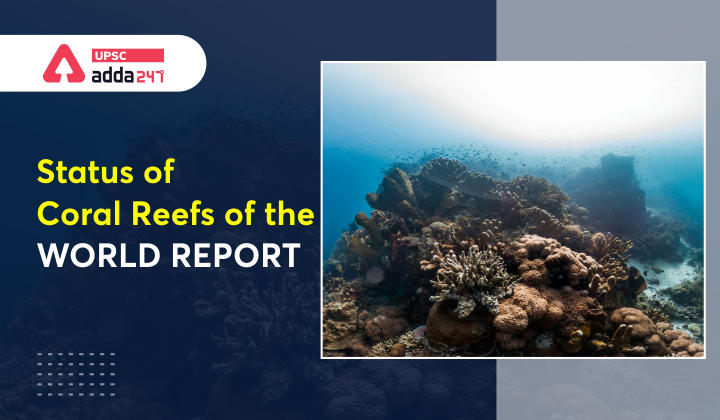Table of Contents
Relevance
- GS 1: Changes in critical geographical features (including water-bodies and ice-caps) and in flora and fauna and the effects of such changes.
Context
- Recently, Global Coral Reef Monitoring Network has released its flagship report titled, ‘Status of Coral Reefs of the World’ to pay special attention on frequent mass global coral bleaching events.
Key points
- The report is funded by the UN Environment Programme (UNEP).
- The report has highlighted that in less than a decade, climate breakdown has led to vanishing of 14 per cent of coral reefs.
State of the World’s Children Report 2021
Coral reefs resilience
- The first global-scale coral bleaching in 1998 affected nearly all coral reef regions of the world.
- It led to the decline of hard coral cover from 32.5% to 30% between 1997 and 2002.
- Between 2002 and 2009, global average hard coral cover returned to pre-1998 levels.
- It meant that in the absence of major global disturbances, many of the world’s coral reefs have remained resilient and capable of recovering, despite the influence of local stressors.
- Since 2009, the overwhelming trend in global average hard coral cover has been downward.
- Between 2009 and 2018, global average hard coral cover declined from 33.3% to 28.8%, which represents a loss of 13.5% of the world’s hard coral.
Coral bleaching
- When the waters get too warm, corals release their colourful micro-algae, turning into a skeletal white colour.
- Bleaching can be equated with ‘canary in the coral mine’.
Algae takeover
- A shift from coral to algae-dominated reefs is evident across the world.
- It reduces the architectural complexity and structural integrity of coral habitats, making them less biodiverse and provide fewer goods and services to humans.
South Asia coral reefs status
Presence
- South Asia region accounts for only 4.2 % of global area of coral reefs.
- Lakshadweep-Maldives-Chagos Ridge accounts for around 75% of the total reef area in the region.
- Despite its relatively small area, South Asia contains a wide variety of coral reef habitats that vary significantly in reef structure, biodiversity, etc.
Threats
- Many reefs face severe human pressure from
- overfishing and destructive fishing,
- coastal development,
- land-based agricultural runoff,
- and increased sedimentation.
- In general, reefs around atolls and offshore islands are subject to less anthropogenic pressure and remain in better condition than those around the South Asian mainland and coastal islands.
- Climate change has increased vulnerability of both coral reefs and coastal communities.
- Sea level rise is a major threat to island communities in the Maldives and Lakshadweep Islands.
With a Bang- IMD’s Rainfall Forecasting Model
Coral reefs significance
Economic significance
- The value of goods and services provided by coral reefs is estimated at US$2.7 trillion per year, including US$36 billion in coral reef tourism.
Ecological significance
- Coral reefs support at least 25% of marine species and underpin the safety, coastal protection, wellbeing, food and economic security of hundreds of millions of people.
- Soft corals bend and sway amongst the craggy mountains of hard corals providing additional homes for fish, snails and other marine creatures.
- Coral reefs harbour the highest biodiversity of any of the world’s ecosystems, making them one of the most biologically complex and valuable on the planet.




 TSPSC Group 1 Question Paper 2024, Downl...
TSPSC Group 1 Question Paper 2024, Downl...
 TSPSC Group 1 Answer key 2024 Out, Downl...
TSPSC Group 1 Answer key 2024 Out, Downl...
 UPSC Prelims 2024 Question Paper, Downlo...
UPSC Prelims 2024 Question Paper, Downlo...
